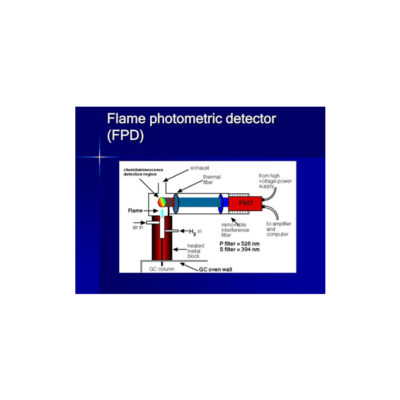-
Flame Photometric Detector (FPD)
FPD detector (includes either sulfur or phosphorus filter) The Flame Photometric Detector can detect sulfur compounds, such as H2S or SO2, down to about 200 ppb and phosphorus compounds to 10 ppb. While not 100% selective, the FPD is 100,000 times more sensitive to sulfur and phosphorus compounds than hydrocarbons. The phosphorus response is linear, and the sulfur response is exponential (twice the sulfur yields four times the peak area).
-
Nitro gen Phosphorus Detector (NPD)
The nitrogen–phosphorus detector (NPD) is also known as thermionic specific detector (TSD) is a detector commonly used with gas chromatography, in which thermal energy is used to ionize an analyte. It is a type of flame thermionic detector (FTD), the other being the alkali flame-ionization detector (AFID also known as AFD).
With this method, nitrogen and phosphorus can be selectively detected with a sensitivity that is 10⁴ times greater than that for carbon
-
Electron Capture Detector (ECD)
The electron capture detector is used for detecting electron-absorbing components (high electronegativity) such as halogenated compounds in the output stream of a gas chromatograph. The ECD uses a radioactive beta particle (electron) emitter in conjunction with a so-called makeup gas flowing through the detector chamber. The electron emitter typically consists of a metal foil holding 10 millicuries (370 MBq) of the radionuclide 63
Ni
. Usually, nitrogen is used as makeup gas, because it exhibits a low excitation energy, so it is easy to remove an electron from a nitrogen molecule. The electrons emitted from the electron emitter collide with the molecules of the makeup gas, resulting in many more free electrons. The electrons are accelerated towards a positively charged anode, generating a current. There is therefore always a background signal present in the chromatogram. As the sample is carried into the detector by the carrier gas, electron-absorbing analyte molecules capture electrons and thereby reduce the current between the collector anode and a cathode. Over a wide range of concentrations the rate of electron capture is proportional to the analyte concentration. ECD detectors are particularly sensitive to halogens, organometallic compounds, nitriles, or nitro compounds. -
Thermal conductivity detector (TCD)
Thermal Conductivity Detector or GC-TCD is a technique used to analyse inorganic / permanent gases (Argon, Nitrogen, Hydrogen, Carbon Dioxide, etc) and small hydrocarbon molecules in addition to moisture . The TCD compares the thermal conductivity of two gas flows – the pure carrier (reference) gas and the sample. Changes in the temperature of the electrically-heated wires in the detector are affected by the thermal conductivity of the gas which flows around this. The changes in this thermal conductivity are sensed as a change in electrical resistance and are measured.
-
Flame Ionization detector (FID)
A flame ionization detector (FID) is a scientific instrument that measures analytes in a gas stream. It is frequently used as a detector in gas chromatography. The measurement of ion per unit time make this a mass sensitive instrument.[1] Standalone FIDs can also be used in applications such as landfill gas monitoring, fugitive emissions monitoring and internal combustion engine emissions measurement[2] in stationary or portable instruments.





